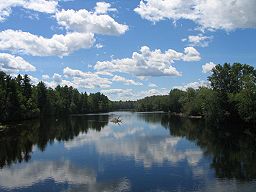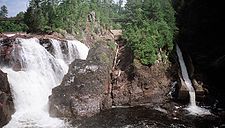- Coulonge River
-
Coulonge River (Rivière Coulonge) Coulonge River near Pont DavidsonCountry Canada State Quebec Region Outaouais Source Lac au Barrage - location Lac-Pythonga, Quebec - coordinates 47°12′30″N 76°53′30″W / 47.20833°N 76.89167°W Mouth Ottawa River - location Fort-Coulonge, Quebec - coordinates 45°51′44″N 76°45′54″W / 45.86222°N 76.765°W Length 217 km (135 mi) Basin 5,060 km2 (1,954 sq mi) Discharge - average 75.35 m3/s (2,661 cu ft/s) The Coulonge River is a predominantly wilderness river in western Quebec, Canada. It is 217 km long, has a drainage area of 5060 km² (source:Atlas of Canada), and runs in a general south-eastern direction from its headwaters in Lac au Barrage (situated in La Vérendrye Wildlife Reserve) to the Ottawa River at Fort-Coulonge, Quebec. Over that distance, it drops approximately 260 meters (850 ft) — 48 meters (157 ft) of that over the massive Grandes or Coulonge Chutes, approximately 15 kilometers (9.3 mi) upstream of the confluence with the Ottawa River.
A popular river for whitewater canoeing enthusiasts, it is often grouped together with the Dumoine and Noire Rivers as three of a kind. The three rivers share the same watershed, and have similar whitewater characteristics. All three empty into the Ottawa River within a distance of 105 kilometers (65 mi) from one another.
History
The Coulonge River is named after Nicholas d’Ailleboust, Sieur de Coulonge, who established a trading post at the mouth of the river in the winter of 1694-95, thereby establishing the first permanent European settlement in the Pontiac region of West Quebec.
One of a dozen or so significant tributaries of the Ottawa River, the Coulonge was used as a waterway by native North Americans and, later, by the coureurs des bois plying their independent trade in furs. In 1835, Scottish-born lumber baron George Bryson acquired timber rights to thousands of acres of forest in the area, including the 200 acres (81 ha) immediately surrounding the Grandes Chutes. To transport the squared timber safely past the falls and the 750 m (2,460 ft) gorge below, Bryson built a 1,000 m (3,300 ft)-long timber slide (a wooden chute flowing with water diverted from the head of the falls) to the calmer waters near the confluence of the Coulonge and Ottawa rivers.
For almost 150 years, the forests around the Coulonge were logged throughout the winter months until spring breakup permitted the massive log drives which, along with similar operations throughout the Ottawa River watershed, fueled the economy of the Ottawa Valley region from the early 19th Century through the middle of the 20th.
The last spring log drive in Canada took place on the Coulonge River in 1982. Since then, the timber from smaller-scale logging operations has been hauled out by trucks over a network of dirt roads which meander throughout the Coulonge River valley.
In 1994, a hydro-electric dam and power station was built at the head of the Grandes Chutes, leaving the Dumoine River as the last major free-flowing tributary of the Ottawa River.
Categories:- Rivers of Quebec
Wikimedia Foundation. 2010.


